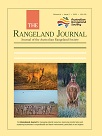
The Rangeland Journal
Volume 44 Number 3 2022
RJ22002Can dingoes increase graziers’ profits and help maintain Australia’s rangelands?
Australia’s largest land predator, the dingo, is targeted and killed in many landscapes in Australia, because of the belief that dingoes will attack all livestock and cause costs to graziers. We provide an alternative view, namely that dingoes reduce the numbers of larger kangaroo species and some feral animals, especially goats. This can stop the uncontrolled over-grazing of landscapes and increase profits of agricultural businesses.
RJ22002 Abstract | RJ22002 Full Text | RJ22002PDF (780 KB) Open Access Article
RJ21013Interactions among climate, topography, soil structure and rangeland aboveground net primary production
 , Ardavan Ghorbani
, Ardavan Ghorbani  , Hossein Arzani, Javanshir Azizi Mobaser and Raoof Mostafazadeh
, Hossein Arzani, Javanshir Azizi Mobaser and Raoof Mostafazadeh 
GrassesComplex inter-relationships among environmental factors in mountain ecosystems structure plant primary productivity. We show that in the northern rangelands of Ardabil province, Iran, elevation is the ultimate driver of ANPP in our system. Elevation effects on precipitation and, secondarily, elevation impacts on soils, including organic matter content are the primary mechanisms linking elevation and ANPP.
RJ22009An objective prioritisation method for agriculture RD&E
Prioritisation of research in agriculture for funding is achieved through processes that vary in complexity. Following a standard comprehensive review with independent economic analyses, a technique of simplified economic analysis of research options by a target group with filtering for RD&E potential while minimising impacts of political agendas was tested to identify priorities to ameliorate calf loss in northern Australia. The aim of this relatively objective technique was to enhance ownership of research, thus subsequent uptake of research outcomes by the target group.
This study investigated how global warming could affect grassland foraging species in Mongolian drylands. Specifically, it explored how the forage quality at both the species and community level could alter under predicted climatic shifts. We believe that our study makes a significant contribution to the literature as previous studies have shown no uniform effects of warming on forage quality.
RJ21055Environmental drivers of above-ground biomass in semi-arid rangelands
Natural rangelands have a variety of vegetation types, soil and topographic properties. Investigation on the relationship between vegetation and environmental factors requires a comprehensive knowledge of the environmental processes that influence vegetation. The effects of soil properties on above-ground biomass were higher than those of climatic properties, at a local scale. Structural equation modelling as a new technique can discern the complex relationships between vegetation and environment for a deeper managerial decision on fragile rangeland ecosystems in arid and semiarid areas.
Legumes have been incorporated into pastures to improve soil fertility and cattle liveweight gains, but there are limited published data on their environmental impacts. Runoff water quality from a newly planted pasture was worse for 2 years following planting compared with established pastures. Overall, greater exports of phosphorus from three improved pastures (butterfly pea, leucaena and buffel grass) were identified as an area of concern, but good pasture management can lower the risk of poor water quality.
RJ22042 Abstract | RJ22042 Full Text | RJ22042PDF (3.7 MB) | RJ22042Supplementary Material (849 KB) Open Access Article



